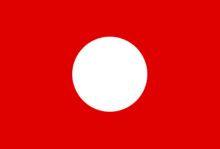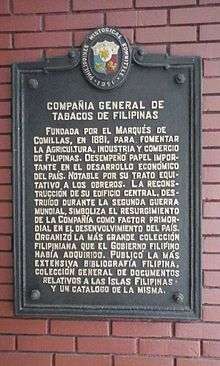Compañía General de Tabacos de Filipinas



The Compañía General de Tabacos de Filipinas, S.A. (General Tobacco Company of the Philippines, abbreviated CdF),[1] also known as the Compañía Española de Tabacos de Filipinas,[2] was the Philippines' first private tobacco company. Founded by Antonio López y López in Barcelona in 1881 and based in Manila, it is also simply known as Tabacos de Filipinas in Spain[3] and as La Tabacalera in the Philippines.[4]
Although the company today specializes in tobacco trading, over the years the company also ran a shipping line and established factories with the aim of cultivating, trading, manufacturing, and commercializing tobacco from the Philippines.[5] It also expanded its interests beyond tobacco, engaging in the exploitation of sugar and alcohol distribution, copra, abacá and maguey,[6] as well as owning significant interests in electricity generation, transport and insurance.
Owned by Spanish interests for most of its history, the Compañía General de Tabacos de Filipinas was in sharp decline between the 1950s and 1990s, during which it sold most of its ancillary businesses in the Philippines to focus solely on international tobacco trading. In 2007, it merged with the Dutch tobacco trading company Lippoel Leaf, forming the CdF International Group, and in 2011, CdF merged again with the American tobacco trading company Hail & Cotton,[7] with the company itself continuing to exist as its Philippine subsidiary.[8]
Activities
- Production and sale of tobacco products.
- Running an ocean line for the transport of merchandise and passengers.
- Commercializing forest products beginning in 1892.
- Production and sale of sugar and alcohol beginning in 1893.
- Production of copra.
- Production of abacá fibre, also known as 'Manila hemp'.[9]
- Production of maguey fibre.
Markets
Regarding distribution, the company operated in three markets:
- Spanish market (Peninsular).
- European market, trading with countries like United Kingdom, Germany, the Netherlands, and Portugal.
- Philippines, the rest of Asia and Oceania.
Credits
The National Historical Institute issued a marker along Romualdez St. in Ermita, Manila in 1951. The marker commends the company for the important role it played in the economic development in the Philippines and for the company's fair treatment of its workers. It also notes that the reconstruction of its central office after World War II symbolizes the reemergence of the company as a key player in the country's progress. The Compañía General de Tabacos de Filipinas is credited to have organized the largest Filipiniana collection that the Philippine Government has acquired.
Further reading
- Emili Giralt i Raventós, La Compañía General de Tabacos de Filipinas 1881- 1981. Barcelona. 1981.
See also
References
- ↑ "Company Overview of Compania General de Tabacos de Filipinas, S.A." Bloomberg L.P. Retrieved March 7, 2017.
- ↑ "El ayuntamiento barcelonés ofreció anoche una cena al señor Macapagal y a su esposa". ABC (in Spanish). July 5, 1962. p. 35.
- ↑ Tabacos de Filipinas
- ↑ Sison, Norman (December 5, 2011). "Tabacalera: 130 years of cigars and Philippine history". The Philippine Star. PhilStar Daily, Inc. Retrieved March 7, 2017.
- ↑ Vida Marítima - Compañia General de Tabacos de Filipinas
- ↑ Fondo documental de la Compañía General de Tabacos de Filipinas
- ↑ "Legacy". Hail & Cotton, International Group. Retrieved March 7, 2017.
- ↑ "Philippines". Hail & Cotton, International Group. Retrieved March 7, 2017.
- ↑ Agricultural Research Services Botanists 1995
External links

- ESTUDIO ECONÓMICO Y CONTABLE DE LA COMPAÑÍA GENERAL DE TABACOS DE FILIPINAS: 1881-1922
- El Pais - Una historia colonial en La Rambla; La vieja sede de Tabacos de Filipinas se transforma en hotel con el evocador nombre de 1898 Former Tabacos de Filipinas head office becomes a hotel